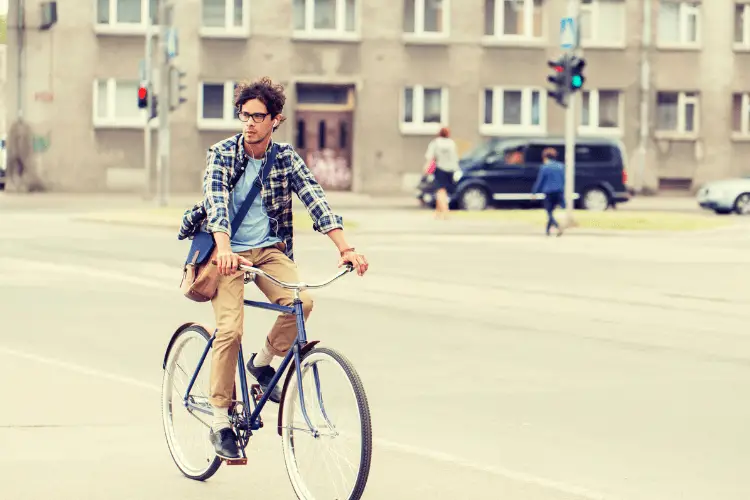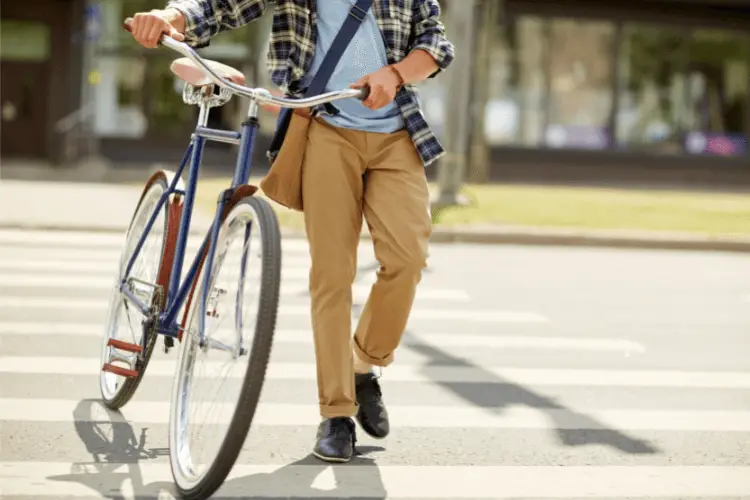No, fixed-gear bikes are not good for long-distance bike rides. The fixed-gear bikes do not have the proper equipment, so the ride becomes intolerable.
What makes fixies unsuitable for long rides? If you already own a fixie, how can you make it more comfortable for a long ride?
We will get into these and more details in the article. So ride along with us.
Quick Navigation
Why Fixies Are Unsuitable For Long Rides

When most of us think of a bike, the first thing that comes to mind is probably a mode of transportation.
A fixie bike is a whole different bike than a standard bicycle. It is frequently referred to as a fixed-gear bike and serves a specific purpose.
A city bike or urban bike is another name for this type of bicycle. Because it is ideally suited for riding in the city, it is not suggested for use on lengthy commutes.
Here are some reasons why fixies are not good for long distances :
1. Inefficiency
Increasing the cadence (number of times the cranks rotate in one minute) on a bicycle leads to a higher average speed. It also simultaneously reduces the amount of energy expended.
The gear ratio cannot be altered in a single-speed bike or a fixie, and an optimal cadence can only be achieved for a relatively short period.
The higher cadence needs more pedaling you do. This makes it difficult and inefficient to ride over long distances.
As a direct result, the bike spends most of its time with a gear ratio that is either “under” or “over.”
When climbing steep terrain, cyclists must move out of the saddle to maximize power transmission and continue moving forward with their bicycle.
However, when going downhill, the rider frequently loses control of the bike since the bike’s speed is greater than the speed that can be achieved by pedaling.
2. The Marathon-Sprint Analogy
The intensity at which marathon runners compete is far lower than sprinters. This way, they can travel longer distances.
Cycling is not all that dissimilar from running because it is driven by human force.
The cyclist’s legs are maintained in a position of mechanical advantage through gears, which reduces the effort required to turn the wheels regardless of the terrain.
The outcome is cycling at a low intensity, which is required for traveling long distances.
If you are not on a level surface and your gear ratio is not already optimized for it, you will not have that option with a bike with only one speed.
3. Joint Pain
Bikes with only one gear can cause damage to the joints, particularly the knees and the hips.
If you pedal in high gear all the time, you run the risk of developing a repetitive stress injury.
On the other hand, geared bicycles alleviate some of the pressure by allowing the rider to select a gear ratio appropriate for their current level of fitness and ability.
4. Greater Fatigue
It would be best if you had an increased energy level to ride a single-speed bike.
Therefore, riders often experience weariness. This can build up over time and become noticeable when traveling long distances.
5. You Have to Travel Light
A lengthy journey necessitates packing additional items, each contributing to the bike’s overall weight.
Because of the additional weight that needs to be transported, the effort required to ride the bicycle would increase significantly.
It is pretty unlikely that you will come across a touring or cargo bike with a single gear.
In this scenario, a lack of physical power and stamina is not the only factor that could be considered. Additionally, the rider’s steadiness is disrupted.
It’s one thing to stand on your bike’s pedals and put in serious effort when you don’t have any cargo. It’s a different ballgame when you’re also lugging around two heavy panniers.
How to Train Yourself to Ride Long Distances on a Fixie

If you are serious about commuting long distances with your fixie, the following are effective methods for doing it.
(i) Bike Configuration
Setting up your fixie is a highly personal choice. However, it is even more crucial to set a fixie to the rider’s specific height and build.
We recommend a steel frame when you ride your fixie since it is more durable. Even though this may be heavier than a frame made of aluminum, the benefits truly exceed this drawback.
The steel frame is superior at absorbing the impact of any bumps on the ground, resulting in a more comfortable ride over long distances.
When customizing your fixie to accommodate your riding style, the following are some considerations you might want to give some thought to:
- Frame material
- Handlebar width
- Sprocket size
- Saddle and how it is arranged
(ii) Increase Your Speed Gradually
To cover long distances while riding a fixie, you need to start moving slowly and then gradually pick up the pace. Start by peddling your bike on a flat surface.
After that, you should focus on pedaling at a consistent tempo while gradually increasing the distance you cover on your bike.
(iii) Use Pedal Straps
If you ride long distances on your fixie, you should invest in a quality set of pedal straps or toe clips that will assist you on both the downstroke and the pedal stroke. When climbing steep hills, a pedal strap will come in handy!
(iv) Have a Good Saddle
This is of the utmost significance. On a traditional road bike, you have the option to stand up and freewheel, which will temporarily relieve the pressure on your buttocks and thighs.
You won’t be able to complete the task on a fixed bike because it requires pedaling. This indicates that the saddle will remain in contact with the bottom of your posterior during the whole of your long-distance ride.
Final Verdict on Are Fixed Gear Bikes Good For Long Distance
Long-distance fixie bike rides are best left to cycling enthusiasts and riders who ride only occasionally. The bike’s ease of use and low maintenance requirements make it easy to have great pleasure when cycling.
When looking for a bike to utilize for your daily commute, you should consider how comfortable it is, how easy it is to use, and how versatile it is. Fixies aren’t the best option to travel a significant distance.

2 thoughts on “Are Fixed Gear Bikes Good For Long Distance? (Answered)”